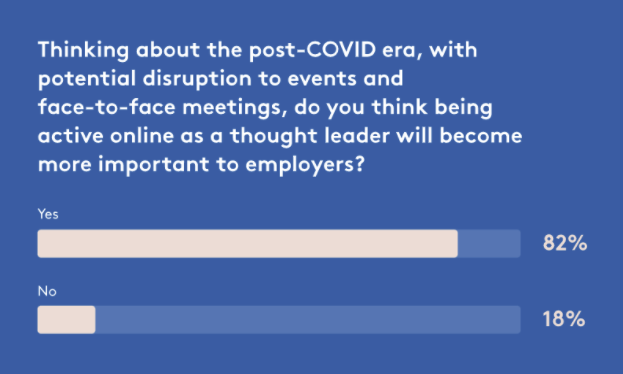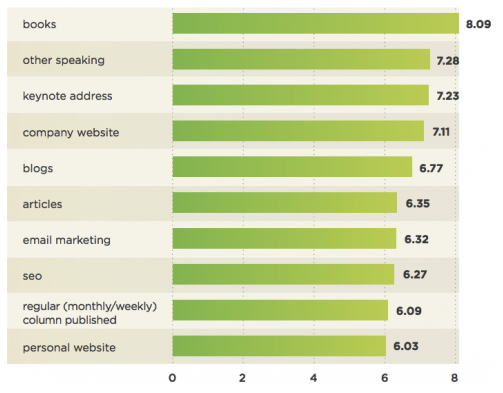Updated February 22, 2022
Personal branding is such a buzzword these days. Marry it to content marketing, and you’ve practically got yourself a swarm (see what I did there?).
Whether you’re starting out in your career or you’re a known thought leader in your space, the content you produce is the first (and often only) indicator of your brand’s value proposition. So how do you go about implementing an effective content marketing strategy for your personal brand?
After all, you may have an endorsement from Bill Gates, but the general public isn’t privy to the details of your relationship. They are, however, consuming your opinions, thoughts, and ideas. And these are the assets that they can reliably evaluate for themselves and, therefore, trust.
That’s the power of content. It’s like being in a perpetual one-sided job interview where you get to provide exceptionally valuable answers.
What Does It Mean to Have a Personal Brand?
Personal branding is about taking deliberate, purposeful steps to build and influence the way you’re perceived by third parties, such as potential employers or customers.
There are specific, tangible benefits to building a stronger personal brand. For instance:
- Clients are prepared to pay more — much more — for the services of known experts. And how do you become a known expert? By working on your personal brand.
- Research published in Frontiers in Psychology reveals that personal branding leads to greater career satisfaction and higher perceived employability.
- 82% of recruiters believe being an active online thought leader — a key part of building a strong personal brand — has become more important since the dawn of the pandemic.
When it comes to strengthening your personal brand, there are lots of avenues you can pursue. According to Hinge Marketing, the 10 most effective tactics for personal branding, in descending order of impact, are:
- Writing a book
- Public speaking
- Giving a keynote address
- Leveraging your company website
- Writing blogs
- Writing articles, including guest posting for third-party publications
- Using email marketing
- Increasing your visibility in search engine results for relevant terms
- Publishing a regular column
- Building a personal website
As with all elements of marketing, a lot of would-be personal thought leaders fall down because they expect instant gratification.
Inevitably, it takes a lot of work to publish a book, or to land the sort of guest posting and public speaking opportunities that will have the biggest impact on your personal brand.
Which brings us to…
The Planning Behind Personal Branding
Personal branding takes work.
But the good news is, your plan doesn’t need the same level of granular detail you’d expect from a corporate content marketing strategy. A step-by-step list of tactics will suffice.
Here’s a simplified version of the steps we take to help our clients build stronger personal brands:
1. Define Your Goals
There’s no set route to building a strong personal brand. That’s because different people want different things from their personal brands.
Some simply want to become better known within a specific sub-niche or geographic location. Others dream of world domination; if they’re not recognized as the number one authority in their industry, they’ve failed in their personal branding mission. Clearly, those two objectives require very different approaches.
So to figure out the best route forward, you first need to set some clear goals for your personal branding project. Start by asking yourself important questions like:
- Who is your audience?
- How well do they know you at the moment?
- Where do they “hang out” online?
- What content formats do they prefer?
- Who are your competitors (i.e. other thought leaders in your space)?
- How actively are they building their own personal brands?
For instance, if your audience loves industry podcasts, a smart goal could be to secure a guest appearance on the three biggest podcasts in your niche within the next 12 months.
2. Lay the Groundwork for Winning High-Profile Opportunities
This stage is the real meat and potatoes of your personal branding content strategy.
Any ambitious personal branding goal is going to require a ton of upfront planning. And if your goal isn’t ambitious, why are you even bothering?
At Content Conquered, we regularly speak to our clients about why they’re doing thought leadership. That’s because, if we know what their aims are, we can create content on their behalf that will help them land the opportunities they need to achieve their objectives.
For instance, if a high proportion of a client’s audience engages with a specific industry website, we can figure out:
- What sort of posts does the website typically publish?
- Which content formats perform best on the site?
- What topics do they like talking about?
- What gaps do they have in their existing content?
- What opportunities are there for us to take a different perspective on existing topics?
Let’s say we’re trying to help our client get published on the imaginary industry website Bow Ties Weekly. After scrutinizing the site’s content, we discover that they love long-form content about exciting new trends in the bow tie world. To be fair, who doesn’t?
So we go away and craft a 3,000-word article for our client’s website on how translucent bow ties are the hottest new neckwear trend.
Now, our client has hard evidence to demonstrate that they know about this topic when approaching Bow Ties Weekly to ask about guest posting opportunities, making it much simpler for them to craft an effective pitch that communicates their value.
The same approach applies to booking speaking engagements. Instead of reviewing past content, we can look at agendas for that event (or similar events) and identify the types of presentations people have been giving. What topics have they covered? What angles have they taken?
With that insight, we can create content that allows our clients to cover the same subjects on their websites. Once it’s published, they’re now ready to approach event organizers for speaking engagements, because they can prove they’re a thought leader on topics they’re likely to care about.
3. Plan Your Amplification Strategy
The final piece in our truncated personal branding process is to think about how you’re going to get more eyes on your content, whatever that content might look like.
Because there’s no point in guest posting for Bow Ties Weekly or giving the keynote address at BowTieCon22 if your efforts end up flying beneath the radar.
Social media is an obvious amplification channel. You can post about your upcoming speaking engagement or share your recently published article to your existing followers and hopefully reach new, relevant audiences at the same time.
Research the best ways to reach your audience through different social channels. For example, tweets are best sent during certain periods of the day, while Instagram posts that receive the most attention often contain specific hashtags.
With a well-designed strategy that supports the promotion of your content, you can focus on creating something that’s impactful, engaging, and fresh.
8 Keys to Well-Made Content
The ideas below are by no means comprehensive but should help to get the wheels turning when it comes to developing your personal branding content strategy:
Think of Things From a Unique Perspective
No one is going to look to you as a thought leader if none of your ideas are original. Instead of rehashing the same old information we’ve all read online a million times, you need to put your personal spin on it. What unique point of view can you bring to the table?
Include Ideas and Resources That Have Not Been Shared
In creative writing, this is referred to as “first-level” creativity. When you’re brainstorming, don’t settle for the first, second, or even fifth idea that comes to mind. Think deeper to find things that are new and fresh.
Empathize With Your Audience
What are their pain points? What are their needs, fears, or aspirations? What’s incredibly challenging to them? Put yourself in your reader’s shoes and walk a day in their life. True understanding helps you write extremely compelling content.
Find Humor In the Humdrum
Humor is a significant barrier-breaker in business. Why else do you think funny pictures of cats took over the internet?
Humanize Yourself
You haven’t been replaced by an AI machine (yet) churning out literature aimlessly into the long night. Be transparent about who you are, what challenges you’ve faced, and how you overcame them. Letting your audience feel like they’re in on a personal secret is a great way to keep them engaged.
Leverage Your Strengths
Are you a data nerd? Showcase numbers in your content. Or maybe you’re more visual? Infographics are still insanely popular. Do you like order and structure? Listicles, my friend, listicles. Sure, they’re nothing new, but they’re still the second most popular blog format. For every human strength, there’s almost always a corresponding audience that embraces that same strength. Don’t shy away from what you’re good at.
Challenge Your Audience
Along with empathy and comfort, your readers also want to be challenged. They want to see things from a different perspective because, frankly, it’s thrilling. Can you imagine telling the dedicated subscribers of Bow Ties Weekly how to tie their bow ties? Of course not, they already know that. Instead, be bold. Take risks. Trust your audience.
Be Professional
I would be remiss to not include this in the list. Your content must be so visually beautiful, grammatically correct, and spelling error free that it could easily contest for a Nobel (if one existed for “Best Content Created for a Content Strategy Used in Personal Branding”). Nobel Prize or not, your audience wants to hear from a professional they can trust, not an amateur.
Not only do the above ideas sound good on paper but they’re all aspects that have formed the cornerstone of crazy successful content marketing campaigns.
So now the only question that remains is: how will you leverage your content marketing to grow your own authority?
Get in touch with Content Conquered today to create a personal branding content marketing strategy that will help you meet your goals and boost your thought leadership profile.
An earlier version of this article appeared on Entrepreneur.


